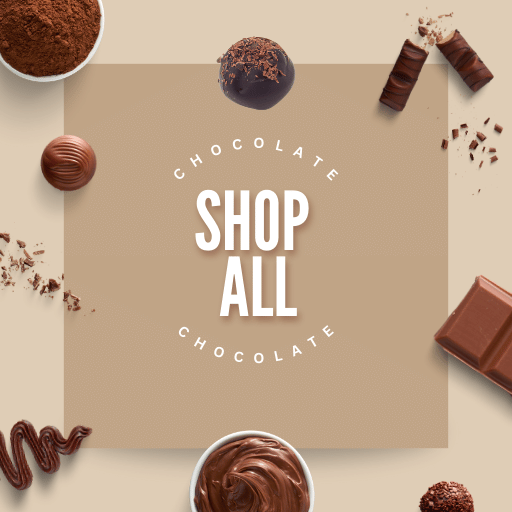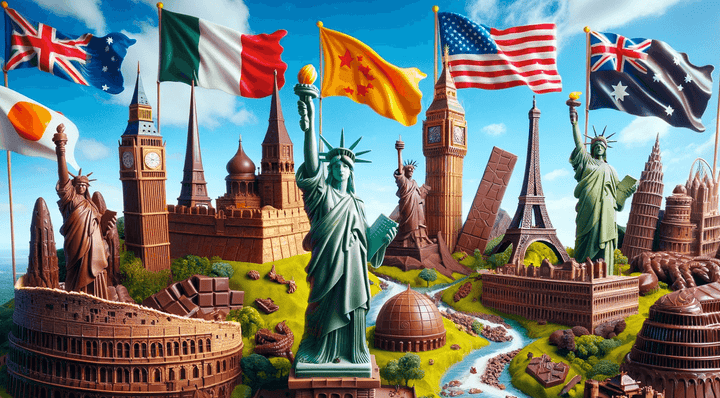Certain countries stand out for their exceptional love and consumption of chocolate, which is rich in velvety luxury.
This post explores the intriguing question: Which country eats the most per capita chocolate?
Which Country Eats The Most Chocolate Per Capita?
Switzerland holds the distinction of consuming the most chocolate per capita.
The Swiss are renowned for their love of chocolate, a reputation well-supported by statistics showing their high consumption levels.
This national preference for chocolate is also reflected in the country's prominent chocolate industry, which is known for producing some of the finest chocolates in the world.
Combining a solid chocolate manufacturing sector and a deep-rooted cultural appreciation for this sweet treat culminates in Switzerland's leading position in chocolate consumption per capita.
Related Post: 11 Chocolate Films
A Chart of the Top Ten Countries - Chocolate Consumption Per Capita
| Country | Per Capita Chocolate Consumption (kg/year) |
|---|---|
| Switzerland | 8.8 kg |
| Germany | 8.4 kg |
| Ireland | 8.3 kg |
| United Kingdom | 8.2 kg |
| Norway | 8.0 kg |
| Sweden | 7.9 kg |
| Denmark | 7.5 kg |
| Netherlands | 7.4 kg |
| Finland | 7.2 kg |
| Belgium | 6.8 kg |
The chart compares per capita chocolate consumption among the top ten countries.
Switzerland leads the chart with an annual consumption of 8.8 kg per person, closely followed by Germany at 8.4 kg.
Ireland and the United Kingdom are also significant consumers, with figures around 8.3 kg and 8.2 kg, respectively.
Scandinavian countries like Norway, Sweden, Denmark, and Finland show high consumption levels, ranging from 8.0 kg to 7.2 kg per capita.
The Netherlands and Belgium, known for their chocolate heritage, round off the list with 7.4 kg and 6.8 kg per person, respectively.
This chart highlights the notable preference for chocolate in European countries, with Switzerland and Germany at the forefront.

Why Is So Much Chocolate Eaten in Switzerland?
Switzerland's renowned status as a top consumer of chocolate per capita can be attributed to several key factors:
-
-
-
Rich Chocolate-Making Heritage: Switzerland has a long-standing chocolate-making tradition dating back to the 19th century. This heritage is deeply embedded in Swiss culture, with generations of chocolatiers perfecting the art of chocolate making. Swiss chocolate is globally recognized for its high quality, naturally encouraging local consumption.
-
Innovation in Chocolate Production: Switzerland has been at the forefront of chocolate innovation. The country is credited with major developments in the industry, such as the invention of milk chocolate by Daniel Peter and the creation of the conching process by Rodolphe Lindt, which significantly improved the smoothness of chocolate.
-
High Standard of Living: Switzerland’s high standard of living and strong economy mean consumers have more disposable income for luxury items like premium chocolate. High-quality chocolate is not only seen as a treat but also as a part of daily life.
-
Tourism and Reputation: Switzerland’s reputation as the ‘home of chocolate’ attracts millions of tourists, many of whom come to taste and purchase Swiss chocolate. This reputation further boosts local consumption, as residents take pride in their national product.
-
Cultural Significance: Chocolate holds a significant cultural place in Switzerland. It's commonly gifted during holidays and celebrations and is integral to Swiss hospitality. The Swiss also value chocolate for its perceived health benefits and often consume it as a comfort food.
-
Local Availability and Variety: Switzerland's wide variety of high-quality chocolates encourages consumption. From supermarket shelves to speciality chocolatiers, Swiss consumers have access to some of the best chocolate in the world.
-
Weather Conditions: Switzerland’s colder climate is also thought to contribute to higher chocolate consumption, as chocolate is often seen as a comforting food during the colder months.
-
-
So, the combination of rich chocolate-making heritage, continuous innovation, economic factors, and cultural significance all contribute to Switzerland's high chocolate consumption.
How Much Chocolate is Eaten In the UK Each Year?
It's generally accepted that the UK is one of the world's largest chocolate consumers.
It was estimated that each person in the UK consumed around 8 kilograms of chocolate annually.
Considering the UK's population of approximately 67 million, this would suggest a total annual chocolate consumption of approximately 536,000 tonnes.
These figures are indicative and subject to change due to market trends, economic conditions, and population changes.
For the most current and precise data, it would be best to consult recent market research reports or official statistics from relevant food and confectionery industry bodies.

Why Do Some Countries Eat More Chocolate Than Others?
The varying levels of chocolate consumption across different countries can be attributed to a combination of cultural, economic, historical, and social factors:
-
-
-
Cultural Significance: In some countries, chocolate plays a significant role in cultural traditions and practices. For example, in Western European countries like Switzerland and Belgium, chocolate is deeply ingrained in the culture and is a source of national pride, leading to higher consumption.
-
Economic Factors: People in wealthier countries tend to consume more chocolate. Their higher disposable incomes allow them to spend more on luxury items like high-quality chocolate. Conversely, chocolate might be considered a luxury few can afford regularly in less affluent countries.
-
Historical Factors: A country's history of chocolate, including how long it has been available and how it was introduced, can impact consumption. Countries with a long history of chocolate making and consumption, like those in Western Europe, often consume more chocolate.
-
Climate and Geography: Chocolate consumption can be influenced by the environment. In colder climates, people might consume more chocolate as a comforting, calorie-rich food. In contrast, hot temperatures can make chocolate less appealing due to its melting tendency.
-
Health and Dietary Trends: Public attitudes towards health and wellness can influence chocolate consumption. In countries with a strong emphasis on healthy eating, there might be less consumption of traditional, sugar-rich chocolates. However, this can be offset by the popularity of dark and artisanal chocolates, often perceived as healthier options.
-
Marketing and Availability: The presence of significant chocolate manufacturers and effective marketing strategies can increase consumption. Additionally, the variety of chocolate products in supermarkets and speciality stores makes them more accessible to consumers.
-
Tourism and Global Reputation: Countries known for their chocolate, like Belgium and Switzerland, often see higher consumption levels, partly due to tourism and the global reputation of their chocolate products.
-
Social Practices: In some societies, chocolate is commonly used as a gift or for celebrations, which can increase consumption. For example, the tradition of giving chocolate on Valentine’s Day, Easter, or Christmas can lead to seasonal spikes in chocolate consumption.
-
-
Some countries eat more chocolate than others, and the reasons are multifaceted, involving a blend of economic capability, cultural heritage, historical development, and social practices.
Where Can You Buy Scrumptious Chocolate?
Whitakers Chocolates, renowned for our long history in crafting delicious and affordable chocolates, offers a range of options suitable for everyone, including vegetarian, vegan, and gluten-free choices.
Our top-selling products, such as indulgent Coffee Creams, Neapolitans, Chocolate Wafer Thins, Stem Ginger and Luxury Chocolate Truffles, are the perfect accompaniments to enhance your mocha coffee experience.
Some Notes From an Expert Chocolatier
As an expert chocolatier, I've observed and contributed to the UK's notable position on the higher end of the global chocolate consumption chart.
In my journey through the world of chocolate, I've crafted various unique and indulgent chocolate creations and have also been a dedicated consumer, appreciating the nuances of different types of chocolate.
My approach has always been to blend tradition with innovation, creating chocolates that resonate with the rich history of chocolate in the UK and appeal to contemporary tastes.
This involves experimenting with a range of flavours, textures, and ingredients that reflect the diverse palette of the British public.
Educating people about the art of chocolate making can heighten their appreciation and enjoyment of chocolate.
Through workshops, tastings, and open conversations, I aim to share my passion and knowledge and encourage more informed and enthusiastic chocolate consumption.
In essence, my role as a chocolatier is twofold: to continue pushing the boundaries of chocolate making, thus keeping the UK's chocolate culture vibrant and evolving, and to indulge in the pleasure of chocolate myself, contributing to our nation’s high chocolate consumption.
It's a delightful responsibility that I embrace wholeheartedly – crafting delicious chocolates for others to enjoy and tasting them myself.

Final Notes On Which Country Eats The Most Chocolate Per Population
The question of which country eats the most chocolate per capita uncovers a fascinating tapestry of cultural, economic, and historical factors that influence chocolate consumption worldwide.
Switzerland, leading the way, exemplifies the intricate relationship between a nation's heritage, standard of living, and culinary preferences.
The Swiss commitment to quality chocolate, coupled with a long-standing tradition of chocolate making and innovation, has positioned them at the top of global chocolate consumption.
However, this exploration goes beyond mere numbers.
It highlights chocolate's unique place in different societies – from a luxury treat to a daily indulgence, from a symbol of national pride to a beloved gift.
Each country's chocolate consumption tells a story about its people, traditions, and lifestyles.
As we consider these varying consumption levels, it's also a reminder of the universal appeal of chocolate.











